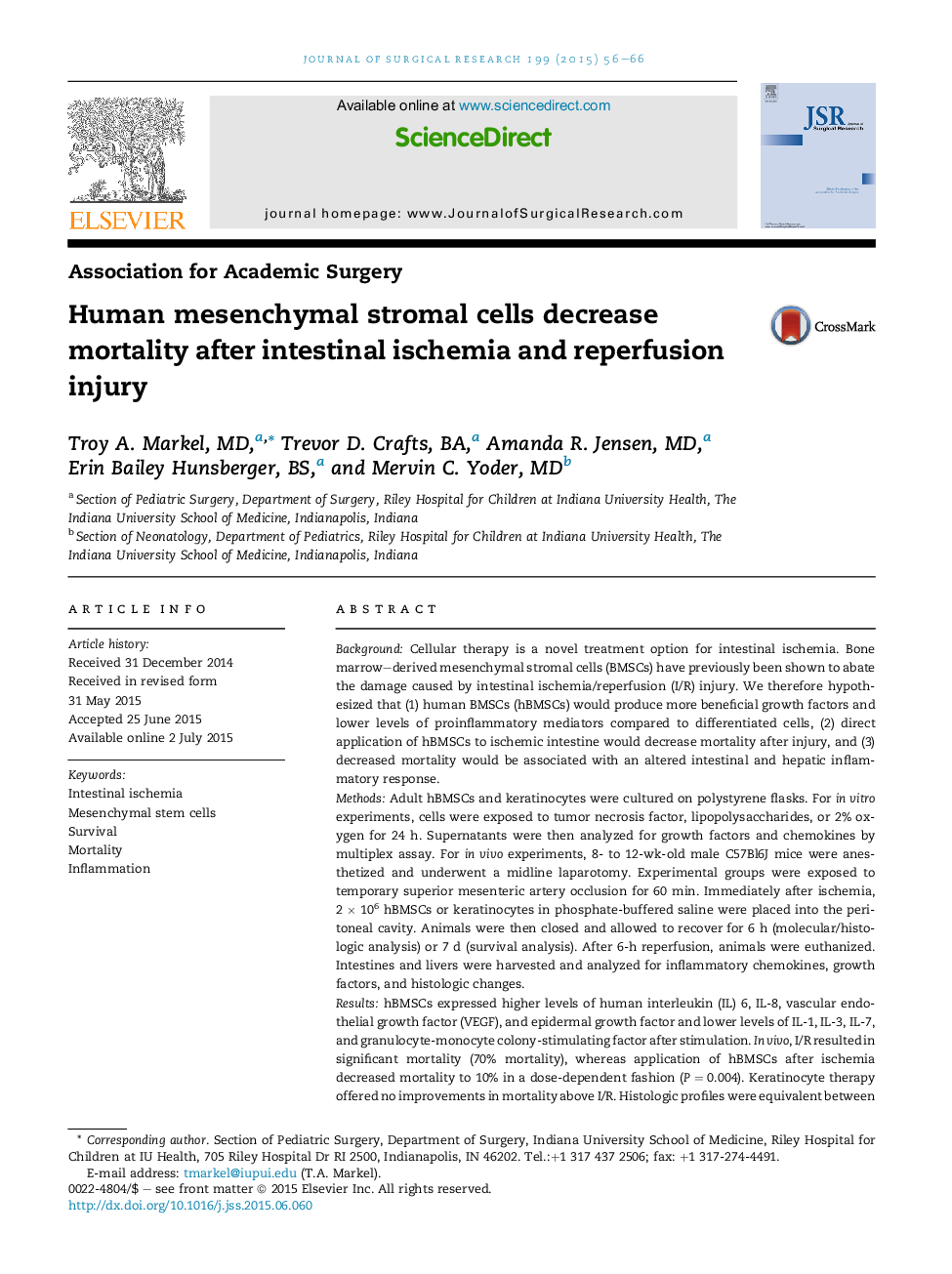| کد مقاله | کد نشریه | سال انتشار | مقاله انگلیسی | نسخه تمام متن |
|---|---|---|---|---|
| 4299593 | 1288396 | 2015 | 11 صفحه PDF | دانلود رایگان |
BackgroundCellular therapy is a novel treatment option for intestinal ischemia. Bone marrow–derived mesenchymal stromal cells (BMSCs) have previously been shown to abate the damage caused by intestinal ischemia/reperfusion (I/R) injury. We therefore hypothesized that (1) human BMSCs (hBMSCs) would produce more beneficial growth factors and lower levels of proinflammatory mediators compared to differentiated cells, (2) direct application of hBMSCs to ischemic intestine would decrease mortality after injury, and (3) decreased mortality would be associated with an altered intestinal and hepatic inflammatory response.MethodsAdult hBMSCs and keratinocytes were cultured on polystyrene flasks. For in vitro experiments, cells were exposed to tumor necrosis factor, lipopolysaccharides, or 2% oxygen for 24 h. Supernatants were then analyzed for growth factors and chemokines by multiplex assay. For in vivo experiments, 8- to 12-wk-old male C57Bl6J mice were anesthetized and underwent a midline laparotomy. Experimental groups were exposed to temporary superior mesenteric artery occlusion for 60 min. Immediately after ischemia, 2 × 106 hBMSCs or keratinocytes in phosphate-buffered saline were placed into the peritoneal cavity. Animals were then closed and allowed to recover for 6 h (molecular/histologic analysis) or 7 d (survival analysis). After 6-h reperfusion, animals were euthanized. Intestines and livers were harvested and analyzed for inflammatory chemokines, growth factors, and histologic changes.ResultshBMSCs expressed higher levels of human interleukin (IL) 6, IL-8, vascular endothelial growth factor (VEGF), and epidermal growth factor and lower levels of IL-1, IL-3, IL-7, and granulocyte-monocyte colony-stimulating factor after stimulation. In vivo, I/R resulted in significant mortality (70% mortality), whereas application of hBMSCs after ischemia decreased mortality to 10% in a dose-dependent fashion (P = 0.004). Keratinocyte therapy offered no improvements in mortality above I/R. Histologic profiles were equivalent between ischemic groups, regardless of the application of hBMSCs or keratinocytes. Cellular therapy yielded significantly decreased murine intestinal levels of soluble activin receptor-like kinase 1, betacellulin, and endothelin, whereas increasing levels of eotaxin, monokine induced by gamma interferon (MIG), monocyte chemoattractant protein 1, IL-6, granulocyte colony-stimulating factor (G-CSF), and interferon gamma-induced protein 10 (IP-10) from ischemia were appreciated. hBMSC therapy yielded significantly higher expression of murine intestinal VEGF and lower levels of intestinal MIG compared to keratinocyte therapy. Application of hBMSCs after ischemia yielded significantly lower murine levels of hepatic MIG, IP-10, and G-CSF compared to keratinocyte therapy.ConclusionsHuman BMSCs produce multiple beneficial growth factors. Direct application of hBMSCs to the peritoneal cavity after intestinal I/R decreased mortality by 60%. Improved outcomes with hBMSC therapy were not associated with improved histologic profiles in this model. hBMSC therapy was associated with higher VEGF in intestines and lower levels of proinflammtory MIG, IP-10, and G-CSF in liver tissue after ischemia, suggesting that reperfusion with hBMSC therapy may alter survival by modulating the systemic inflammatory response to ischemia.
Journal: Journal of Surgical Research - Volume 199, Issue 1, November 2015, Pages 56–66
